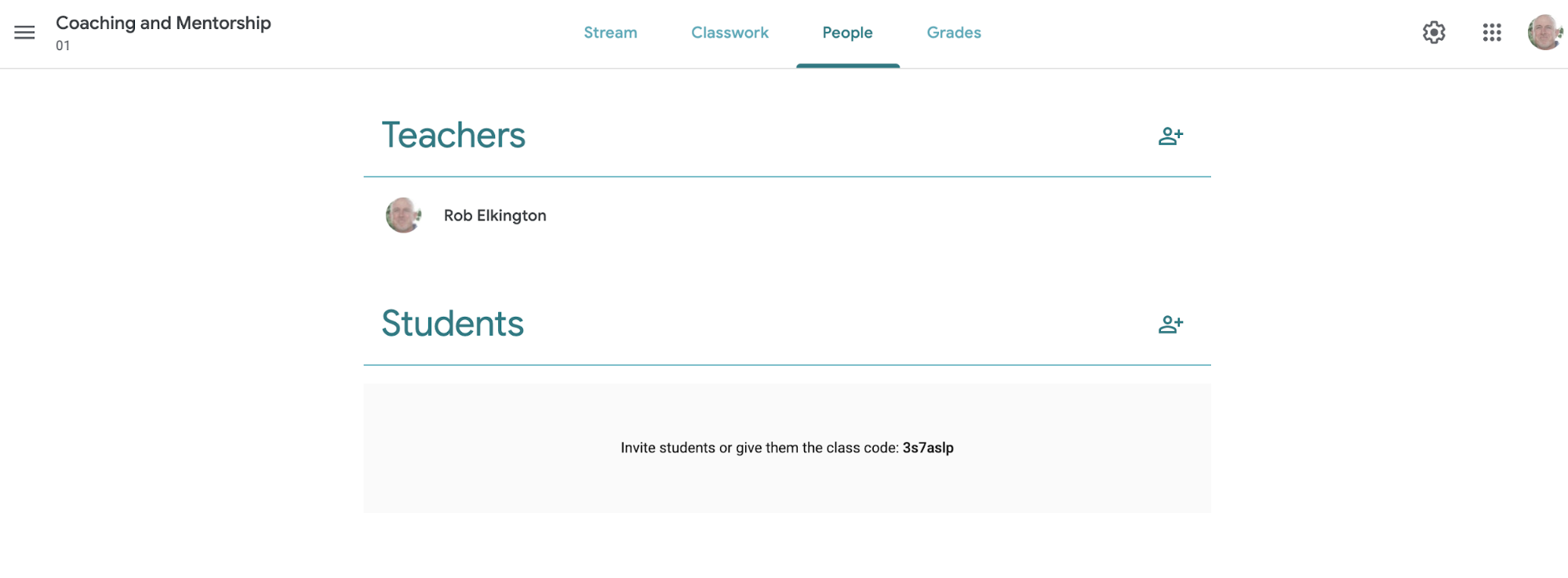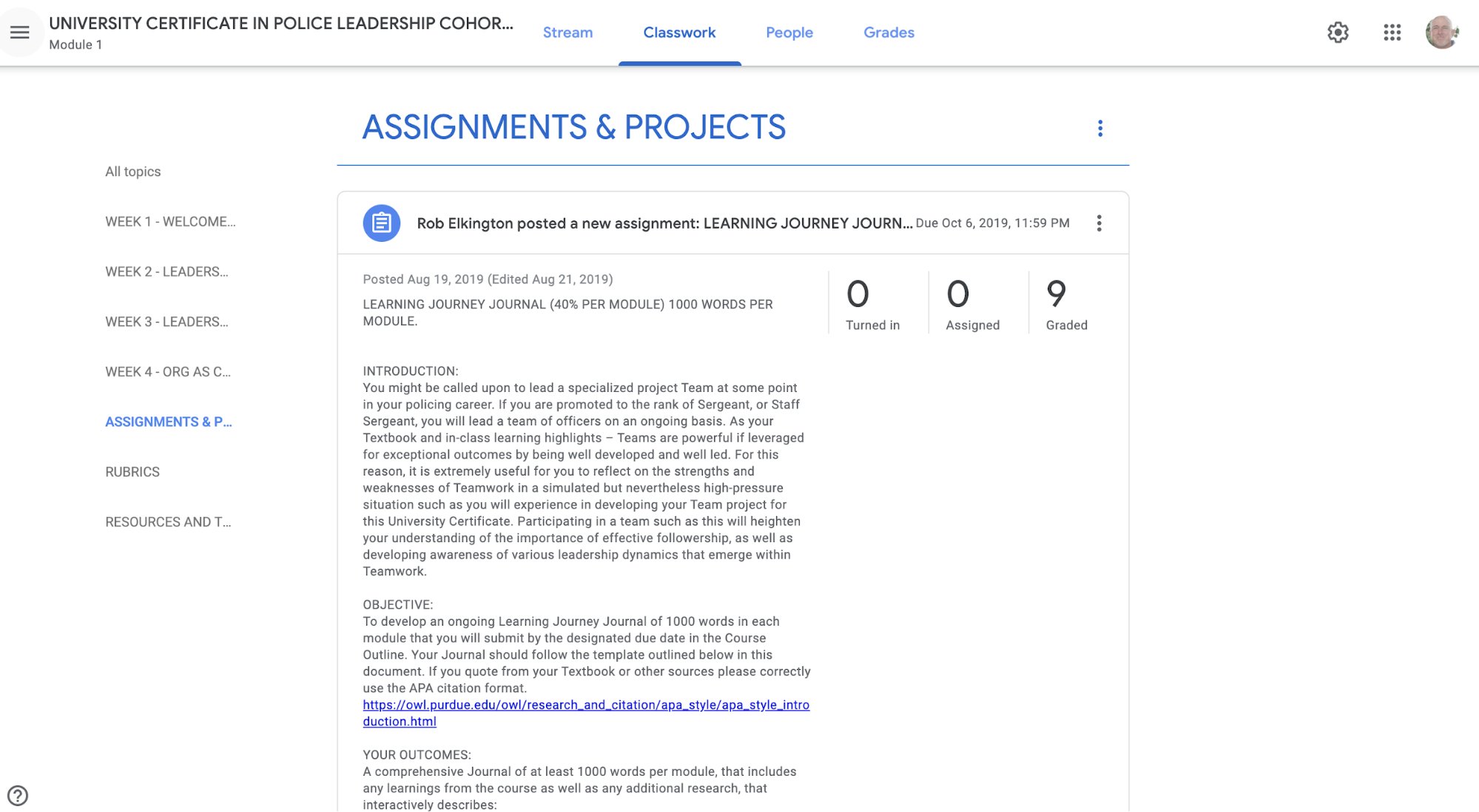Using Google Classroom as a Learning Management System
Rob Elkington
Introduction
The development of several fully online University Certificates such as Visionary Leadership, Coaching for Performance and Mentorship, and Police Leadership, required an LMS that:
- Is cost-effective.
- Does not require a student number for each student.
- Is scalable to mobile or smartphone platforms.
- Facilitates peer discussion.
- Supports a journaling feature.
- Supports video lectures.
- Supports the inclusion of video clips from You-Tube.
- Supports student messaging.
Over the five years since its creation, Google Classroom has evolved as an LMS that supports all of the features mentioned above. To select Google Classroom, you search for “Google Classroom” in Google. You will need to use your institutional credentials to access Google Classroom, provided your institution has subscribed to the Google suite.
Resources
- Laptop or desktop to create a course, and course modules.
- Links to YouTube videos.
- Links to video lectures.
Steps for Implementation
Step 1. Navigate to Google Classroom
Navigate to Google Classroom and sign in using your institutional credentials. You can either search for Google Classroom using Google search or sign in to your Google suite using your institutional credentials.
Step 2. Create your course
Click on the + sign in the right-hand corner of the screen to create your course.
You will need to name your course and indicate the section of the course as well as the specific subject matter within the course. You can also assign a room number for the course if you have more than one cohort of students enrolled in the course.
Step 3. Create topics within the course.
Click on the + sign to create topics within the course.
Now that you have created your course you will need to create the topics for your course such as:
- Course Outline
- Session 1
- Session 2
- Session 3
You can sequence your modules by easily dragging and dropping each module to the preferred level.
Step 4. Populate your topics
Populate your topics with the material required for student learning. Within your topic you click the + sign and choose to add either:
- An Assignment.
- A Quiz Assignment.
- A Question, or Discussion Question.
- The material comprising either:
- A pdf. document.
- A Word document.
- A video clip.
- A PowerPoint presentation.
Step 5. Invite students to join the class.
Once you have completed the development of your course in Google Classroom you invite students to join either by clicking on the +sign in the “Students” tab or by sending the students an email with the course code included.
Top Tips for Success
- Include as much video as possible.
- Pre Design your topics to ensure there is a clear “flow” to the work.
- Use the features included with Google Classroom for ease of access such as:
- The Journaling feature.
- The Quiz feature.
- The Question / Discussion question feature.
Further Reading to Support the Use of Google Classroom
Heggart, K. R., & Yoo, J., (2018). Getting the Most from Google Classroom: A Pedagogical Framework for Tertiary Educators.
Australian Journal of Teacher Education, Vol. 43 (3). http://dx.doi.org/10.14221/ajte.2018v43n3.9
Iftakar, S., (2016). Google Classroom: What Works and How? Journal of Education and Social Sciences, Vol. 3, (February).
Keeler, A., & Miller, L., (2016). 50 Things You Can Do With Google Classroom. Dave Burgess Consulting, Inc.
Scholl, H., (2019). My Google Classroom Training Guide. Estalontech, 2019.
Author

Rob Elkington, Ph.D. is an Adjunct Professor at the Ontario Tech University where he works with the Faculty of Business and IT, the Faculty of Education, and the Faculty of Social Sciences. Rob is also a Senior Lecturer with the Stellenbosch University School of Public Leadership. Rob serves as Sessional Lecturer with Trent University Durham. Rob facilitates a number of undergraduate courses related to leadership such as Collaborative Leadership, Leadership Negotiation and Teamwork, Business and Personal Ethics, Critical Thinking and Ethics, Foundations of Leadership. Rob also facilitates graduate courses such as Leadership and Technology, Leadership Fundamentals, Foundations of Leadership, Organizational Effectiveness, and Ethical Leadership.










